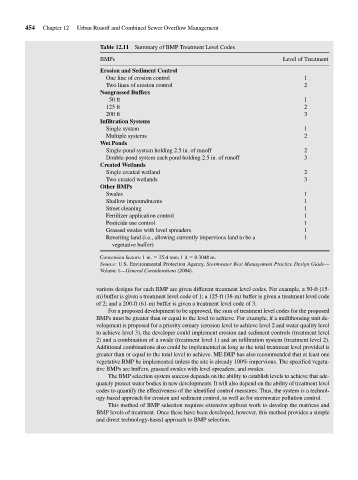Page 496 - Fair, Geyer, and Okun's Water and wastewater engineering : water supply and wastewater removal
P. 496
JWCL344_ch12_398-456.qxd 8/4/10 9:37 PM Page 454
454 Chapter 12 Urban Runoff and Combined Sewer Overflow Management
Table 12.11 Summary of BMP Treatment Level Codes
BMPs Level of Treatment
Erosion and Sediment Control
One line of erosion control 1
Two lines of erosion control 2
Nongrassed Buffers
50 ft 1
125 ft 2
200 ft 3
Infiltration Systems
Single system 1
Multiple systems 2
Wet Ponds
Single-pond system holding 2.5 in. of runoff 2
Double-pond system each pond holding 2.5 in. of runoff 3
Created Wetlands
Single created wetland 2
Two created wetlands 3
Other BMPs
Swales 1
Shallow impoundments 1
Street cleaning 1
Fertilizer application control 1
Pesticide use control 1
Grassed swales with level spreaders 1
Reverting land (i.e., allowing currently impervious land to be a 1
vegetative buffer)
Conversion factors: 1 in. 25.4 mm; 1 ft 0.3048 m.
Source: U.S. Environmental Protection Agency, Stormwater Best Management Practice Design Guide—
Volume 1—General Considerations (2004).
various designs for each BMP are given different treatment level codes. For example, a 50-ft (15-
m) buffer is given a treatment level code of 1; a 125-ft (38-m) buffer is given a treatment level code
of 2; and a 200-ft (61-m) buffer is given a treatment level code of 3.
For a proposed development to be approved, the sum of treatment level codes for the proposed
BMPs must be greater than or equal to the level to achieve. For example, if a multihousing unit de-
velopment is proposed for a priority estuary (erosion level to achieve level 2 and water quality level
to achieve level 3), the developer could implement erosion and sediment controls (treatment level
2) and a combination of a swale (treatment level 1) and an infiltration system (treatment level 2).
Additional combinations also could be implemented as long as the total treatment level provided is
greater than or equal to the total level to achieve. ME DEP has also recommended that at least one
vegetative BMP be implemented unless the site is already 100% impervious. The specified vegeta-
tive BMPs are buffers, grassed swales with level spreaders, and swales.
The BMP selection system success depends on the ability to establish levels to achieve that ade-
quately protect water bodies in new developments. It will also depend on the ability of treatment level
codes to quantify the effectiveness of the identified control measures. Thus, the system is a technol-
ogy-based approach for erosion and sediment control, as well as for stormwater pollution control.
This method of BMP selection requires extensive upfront work to develop the matrices and
BMP levels of treatment. Once these have been developed, however, this method provides a simple
and direct technology-based approach to BMP selection.

